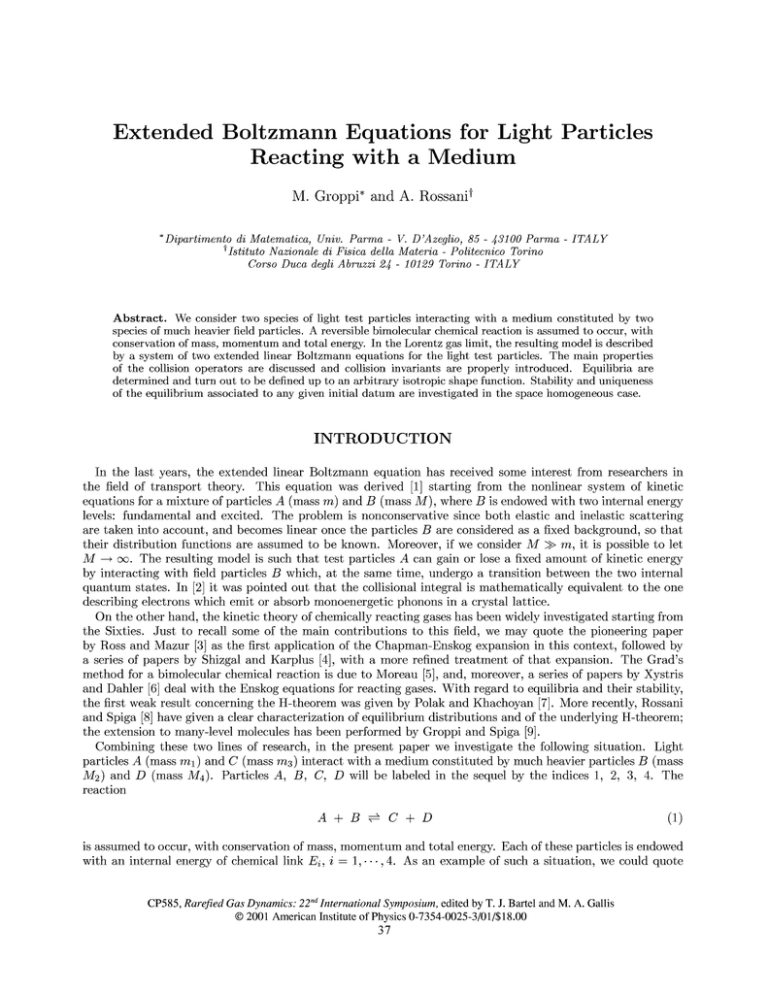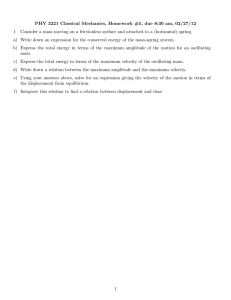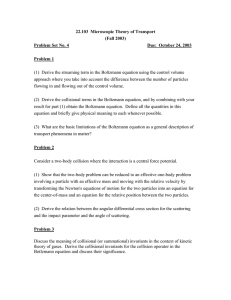Extended Boltzmann Equations for Light Particles Reacting with a Medium "
advertisement

Extended Boltzmann Equations for Light Particles
Reacting with a Medium
M. Groppi* and A. Rossani1"
*Dipartimento di Matematica, Univ. Parma - V. D'Azeglio, 85 - 43100 Parma - ITALY
^Istituto Nazionale di Fisica della Materia - Politecnico Torino
Corso Duca degli Abruzzi 24 - 10129 Torino - ITALY
Abstract. We consider two species of light test particles interacting with a medium constituted by two
species of much heavier field particles. A reversible bimolecular chemical reaction is assumed to occur, with
conservation of mass, momentum and total energy. In the Lorentz gas limit, the resulting model is described
by a system of two extended linear Boltzmann equations for the light test particles. The main properties
of the collision operators are discussed and collision invariants are properly introduced. Equilibria are
determined and turn out to be defined up to an arbitrary isotropic shape function. Stability and uniqueness
of the equilibrium associated to any given initial datum are investigated in the space homogeneous case.
INTRODUCTION
In the last years, the extended linear Boltzmann equation has received some interest from researchers in
the field of transport theory. This equation was derived [1] starting from the nonlinear system of kinetic
equations for a mixture of particles A (mass m) and B (mass M), where B is endowed with two internal energy
levels: fundamental and excited. The problem is nonconservative since both elastic and inelastic scattering
are taken into account, and becomes linear once the particles B are considered as a fixed background, so that
their distribution functions are assumed to be known. Moreover, if we consider M ^> ra, it is possible to let
M —»• oo. The resulting model is such that test particles A can gain or lose a fixed amount of kinetic energy
by interacting with field particles B which, at the same time, undergo a transition between the two internal
quantum states. In [2] it was pointed out that the collisional integral is mathematically equivalent to the one
describing electrons which emit or absorb monoenergetic phonons in a crystal lattice.
On the other hand, the kinetic theory of chemically reacting gases has been widely investigated starting from
the Sixties. Just to recall some of the main contributions to this field, we may quote the pioneering paper
by Ross and Mazur [3] as the first application of the Chapman-Enskog expansion in this context, followed by
a series of papers by Shizgal and Karplus [4], with a more refined treatment of that expansion. The Grad's
method for a bimolecular chemical reaction is due to Moreau [5], and, moreover, a series of papers by Xystris
and Dahler [6] deal with the Enskog equations for reacting gases. With regard to equilibria and their stability,
the first weak result concerning the H-theorem was given by Polak and Khachoyan [7]. More recently, Rossani
and Spiga [8] have given a clear characterization of equilibrium distributions and of the underlying H-theorem;
the extension to many-level molecules has been performed by Groppi and Spiga [9].
Combining these two lines of research, in the present paper we investigate the following situation. Light
particles A (mass mi) and C (mass 7713) interact with a medium constituted by much heavier particles B (mass
M%) and D (mass M±). Particles A, B, C, D will be labeled in the sequel by the indices 1, 2, 3, 4. The
reaction
A + B ^ C + D
(1)
is assumed to occur, with conservation of mass, momentum and total energy. Each of these particles is endowed
with an internal energy of chemical link Ei, i = 1, • • • ,4. As an example of such a situation, we could quote
CP585, Rarefied Gas Dynamics: 22nd International Symposium, edited by T. J. Bartel and M. A. Gallis
© 2001 American Institute of Physics 0-7354-0025-3/01/$18.00
37
the reversible bimolecular reaction H<2 + Cl ^ H + £TC7 in a background formed by Cl and ffCT, which
are much heavier than H<2 and H.
We start from the nonlinear system of kinetic equations for the mixture of particles A, B, C, D, and,
consistently with the above assumption, we let M2 —> oo and M4 —> oo, keeping (M2/M4) —>• 1 (Lorentz gas
limit). Let us call /2(v) and /4(v) the distribution functions of particles 2 and 4, respectively. Because of the
further assumption that particles 2 and 4 are much more numerous and can be treated as a background, it
is reasonable to assume that their distribution functions are equilibrium Maxwellians with no drift, so that,
when we let the masses tend to infinity, we get Dirac's distributions
/2(v)
= N26(v),
/ 4 (v) = A/4<5(v),
(2)
where N% and N± are the number densities (given constants) of particles 2 and 4, respectively. The resulting
model is described now by a system of two linear Boltzmann equations for test particles 1 and 3.
This paper is organized as follows. In the second section we deduce the system of extended linear Boltzmann
equations, in the Lorentz gas limit, starting from the full nonlinear description [8], In the following section we
introduce collision invariants and derive the relevant macroscopic conservation equations. In the final section,
we investigate equilibria and their stability by means of suitable Lyapunov functionals.
With respect to the nonlinear kinetic description, some of its main features are reproduced, while the
Lorentz limit introduces new interesting aspects, such as no correlation between equal particles at different
speeds, implying non uniqueness of equilibria, defined up to an arbitrary isotropic function.
DERIVATION OF THE EXTENDED LINEAR BOLTZMANN EQUATIONS
The nonlinear integrodifferential Boltzmann equations governing the evolution of the distribution function
J = (/i, /2, /s, /4) for a mixture of 4 chemically reacting gases read as [8]:
^ + v - ^ = Ji[/] + Qi[/]
* = !,...,4.
(3)
On the right hand side of (3), J^[/], i = 1, • • • ,4, stands for the chemical collision integral, and Qi[/], i =
1, • • •, 4, is the elastic contribution.
Again from ref. [8], for i = I we have
f
\ 3
dwdn'
• n'
(4)
TYl 'TY1 ~
where A£" = E$ + E^ — EI — E% (and it can always be assumed that AE > 0), LJL^ = -——-—-—- is the reduced
(mi+mj)
mass, and z'fl (#, n • n') is the differential collision frequency relevant to the direct (endothermic) reaction. The
microreversibility condition
l\
2
34 rr /
2
^^J-' \
1 /
34
/x
, n • n J = /ig^ g±2 U \ g — ——— 1 2/342 v^i 2 , n • n j
eliminates one of the collision frequencies; here gf 2 =
—— I g — ——— I
LM34 V
/^x
(^oj
is the post-collisional relative
M12 J\
speed in the direct process, while n and nx are the unit vectors of the relative velocities before and after
collision, respectively. The velocities after collision are given by
V
W
34
rai
^ii + 2
ra2
77i i + 77i2
,
m4
ms + 1714
v
12 = ———————
+ ——————— w + ———————
m
34
m
i
mi + rri2
,
m
2
mi + m<2
12 = ——————— v + ——————— w -
rn3
ms + m
34
34
The unit step function U accounts for the threshold in the endothermic reaction, that is prevented in case of
insufficient impinging kinetic energy of the relative motion. The other chemical contributions Ji relevant to
i = 2, 3, 4 can be obtained from Ji by proper permutation of indices [8].
38
The nonlinear elastic collision integrals in (3) for i = 1 is given by
7,n • n') [/!(v«)/, (w«) - /i(v)//(w)] dwdn',
Qi [/](v) =
(7)
where the expressions for post-collisional velocities vj| and wj| are well known [10]; contributions Qi for
i = 2,3,4 can be obtained analogously.
It has been proved [8] that the equilibrium distributions / = (/i, /2, /s, /4) for the set of nonlinear equations
(3) are Maxwellians, in which the number densities satisfy the following condition
7V4
KT
(8)
'
representing the mass action law for the considered reaction.
Now observe that, in the Lorentz gas limit for the considered problem (that is
—> 1) we have
oo and
oo with
v=
012 -» V13 =
,34
,12
ra3
yj
Jj
+«
(9)
W.
By inserting the limiting expression (2) into (4) and (7) and by taking into account the implication (9) of
the Lorentz gas assumption, we obtain a system of two linear Boltzmann equations for the evolution of the
distribution functions of test particles
(10)
or, explicitly,
%
dt
9x
= f
JS2
(n)
where the chemical reaction and elastic collision kernels are respectively given by
—
N4f3(vi3£l') - N2fi(v)
Riifi] = [N2 v$(v, n • n') + ^4 i/i" («, n • n')] [/i(wn') - A(v)]
(12)
(13)
and, by using the microreversibility condition,
(14)
(v, n • n')
(15)
COLLISION INVARIANTS AND MACROSCOPIC EQUATIONS
Having in mind concepts and ideas from kinetic theory [10], let us introduce an arbitrary pair of smooth
functions 0(v) = (0i(v),0s(v)) and consider the functional C(0) = Cch(<f)) -hC e ^(0), where
39
(0) = f
~
</R
(v) - 03K-3n')] dvdn'
R 3 xS 2
(16)
(IT)
Based on these expressions, we can define as collision invariant any pair (0i(v),0s(v)) satisfying the requirements
k
01 (v)
=
0i (v)
03 (v)
=
03 (t>)
03 M
=
0i
(18)
They must be isotropic, and are defined up to an arbitrary smooth function of v. In this way, of course,
C[0] =0 whenever 0 is a collision invariant.
In particular, if we multiply the kinetic equations (11) by the collision invariant 0i(t>) = 0s (f) = 1, sum the
two equations, and integrate over the kinetic variable v, we find, in space homogeneous conditions,
hi+n3 = Q
(19)
that is, the total number of test particles is conserved. Moreover, starting from the collision invariant <f>i(v) =
-rait> 2 , 03(v) = —^1(^31 )2 = -m^v2 + A£", we obtain
z
z
z
£ = ~h3AE = hiAE
(20)
that represents the balance equation for overall test particle kinetic energy
"1
1
2
dv.
and define the functional
Let us now consider 0i(v) = log[7V 2 /i(v)/mf], 0s (v) =
+
(21)
III {
After some algebra, we obtain, under standard positivity assumptions on collision frequencies and distribution
functions
log
rr
• 11 [N<2v\l(v, n - n') + W41/14(v,n -fiOl/iO^O
\ f (v\
f
/
/}
-1
log-
- 1 log
40
(22)
Since, for x > 0, the convex function (x — l)logx is non-negative, and vanishes only at x = 1, from (22) we
can establish the sign of W and generalize the classical Boltzmann inequality.
Theorem 1 The functional W[/i, fs] defined by (21) is such that W < 0 V(/i, f%), and more precisely W = 0
if and only if
h(v]
/s(v)
=
(23)
Vv G R+.
TTlq
Notice that chemical reaction establishes a correlation between particles 1 at a speed v > \/2A.E/rai and
particles 3 at the corresponding speed w = v±3 > 0. Particles 1 at a speed v < ^/2AEJm^ are not involved in
the correlation since chemical reaction is not allowed to them.
A further application of the collision rate expressions (16) and (17) is the derivation of the macroscopic
conservation equation that is in order in our case. Consider an arbitrary collision invariant (0i,0s), that can
be written, without loss of generality, as 0i(v) = <3>(t;), 0s (v) = $(VJH_), where $ is an arbitrary isotropic
function. Then the collision rate equation C[0] =0 can be rewritten as
/
Jo
1713
dv = 0.
mi
(24)
By taking into account the arbitrariness of $(v) and the kinetic equations (11) we finally get the following
continuity equation
(25)
where p(v) is a partial density at speed v collecting in appropriate way the two species of test particles and is
defined as
~~
"'
in.
(26)
EQUILIBRIUM AND STABILITY
A collision equilibrium can be defined, like in [10], as any pair of distribution functions (/i,/s) for which
/sl+Qi[/il
=
0
Vv 6 R3.
(27)
By means of the Boltzmann inequality, the following theorem can be proved:
Theorem 2 The pair (/i,/a) is a collision equilibrium if and only if satisfies conditions (23), that is equilibria
are isotropic functions defined up to an arbitrary shape function F(v) ( such that 4-7T / F(v)v2dv = 1) as
follows
fi(v)
=
(28)
41
This theorem represents the extended version of the detailed balance principle that is valid in the present
context, binding collision invariants to equilibria.
7771
\ "/2
( -—== )
ZTTjrv 1 /
/
7771
\
\
2K1
/
exp (— ———v ), in such a way that the equilibrium distribu-
tion f i ( v ) = niF(v) is a Maxwellian at temperature T, correspondingly also /3 turns out to be the Maxwellian
at the same temperature
3/2
(29)
2KT
where the number density 77,3 is related to HI by
(30)
It is interesting to observe that the present relationship (30) could also be obtained from the nonlinear mass
action law (8) in the Lorentz gas limit.
In general, for an arbitrary equilibrium characterized by F(v), the following relationship between number
densities is in order
A T 2 / m 3 \ * 4?r ^
LTT
—
N4 \mij
^-FMv2dv
J/0
which can be viewed as the general mass action law holding in this linear limiting context.
We restrict ourselves now to the space homogeneous evolution problem starting from a given initial state.
The continuity equation (25) yields the first integral p(v) = p°(v), where p° is uniquely determined from (26)
when initial conditions (/^,/s) are assigned. At equilibrium, from (28), we obtain
(31)
1 +U
(v2-2-^}(^}2^
Then, by equating (31) to pQ(v) we have
Theorem 3 There exists a unique equilibrium associated to any initial datum
eq
A*)
,
-i
2A£ N
mi
47T
), given by
ml
(32)
In order to study stability under collision of the equilibrium (/i 9 , f 3 q ) associated to a given initial condition,
introduce the ff-functional
H[fiJ3}=
/i(v)JV2 , ,( ,, / 3 (v)/
^^+/3(v)log^-f
dv.
(33)
777,0
It is possible to prove that the following H-Theorem holds.
Theorem 4 The functional H in (33) is a strict Lyapunov functional in space homogeneous conditions for the
unique equilibrium (/i 9 ,/3 9 ) determined by (/fj/s), in the sense that
tJa] < 0,
H[fi, /a] - H [/!", ff] > 0
and H[fi,f3] = 0 iff (A, /3) = (/f ,
for any (flt /3) ^ (/?, f f ) .
42
(34)
The proof follows similar steps as in [8], First, we can see by direct computation that H = W, and then the
former requirement in (34) follows immediately from Theorem 1. For the latter, if we write H in the form
H = I Hdv, bearing in mind the conservation equation, we obtain after some algebra:
eq
eq
(35)
and then it is possible to write
H [/i, /3] - H[f?>, fezq] =
(U - UL) dv
(36)
where 1~LL denote the first-order Taylor polynomial of 1~L. Since H, is a convex function for /i > 0, f$ > 0, the
integrand in (36) is non negative, and vanishes if and only if (/i, /s) coincides with (/i 9 , /a 9 ), which completes
the proof.
We can observe that the property H < 0 may be linked to the entropy law for the present non-isolated
system of test particles.
It is possible to prove that also
is a strict Lyapunov functional for the present problem.
CONCLUSIONS
A linear Boltzmann model can be constructed in the case of light test particles reacting with a medium
of heavy field particles, starting from the nonlinear kinetic description of reversible bimolecular reactions in
chemically reacting gases. The Lorentz limit introduces, especially from a mathematical point of view, new
interesting aspects typical of linear transport theory. Some of the classical problems of neutron transport
theory can be revisited in such a new context. Indeed, this is a kind of two-species monoenergetic transport
[11]. On the other hand, by dropping the strong assumption that field particles are described by Dirac's delta
distribution functions, one could introduce instead more realistic Maxwellians at a fixed temperature. For such
a new model, an interesting connection between H-theorem and Clausius inequality can be foreseen [12].
ACKNOWLEDGMENTS
Work performed in the frame of the activities sponsored by MURST, and by the University of Parma,
through the National Research Project "Mathematical Problems of Kinetic Theories". Helpful discussions
with G. Spiga are gratefully acknowledged.
REFERENCES
1.
2.
3.
4.
5.
6.
7.
8.
9.
10.
11.
12.
Garibotti, C. R., and Spiga, G., J. Phys. A: Math. Gen. 27, 2709-2717 (1994).
Rossani, A., Riv. Mat. Univ. Parma (5) 6, 35-45 (1997).
Ross, J., and Mazur, P., J. Chem. Phys. 35, 19-28 (1961).
Shizgal, B., and Karplus, M., J. Chem. Phys. 52, 4262-4278 (1970).
Moreau, M., Physica 79A, 18-38 (1975).
Xystris, N., and Dahler, J. S., J. Chem. Phys. 68, 354-373 (1978).
Polak, L. S., and Khachoyan, A. V., Soviet J. Chem. Phys. 2, 1474-1485 (1985).
Rossani, A., and Spiga, G., Physica A 272, 563-573 (1999).
Groppi, M., and Spiga, G., J. Math. Chem. 26, 197-219 (1999).
Cercignani, C., The Boltzmann Equation and its Applications, Springer, New York, 1988.
Case, K. M., and Zweifel, P. F., Linear Transport Theory, Addison-Wesley, Reading, 1967.
Rossani, A., and Kaniadakis, G., Physica A 277, 349-358, (2000).
43





